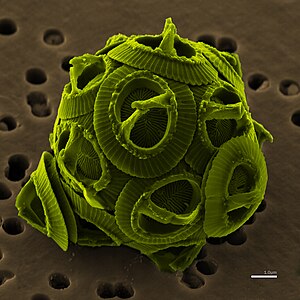하크로비아
하크로비아(Hacrobia)는 SAR 상군에 포함되지 않는 크로말베올라타의 단계통군의 하나이다.[1]
|
| ||
|---|---|---|
 Gephyrocapsa oceanica | ||
| 생물 분류ℹ️ | ||
| 역: | 진핵생물 | |
| (미분류): | 식물+HC+SAR 대형군 | |
| (미분류): | 하크로비아 (Hacrobia) Okamoto et al., 2009 | |
학명이명 | ||
|
CCTH | ||
| 아군 | ||
|
| ||
다음 생물군을 포함하고 있다.
과거에는, 부등편모조류와 착편모조류 그리고 은편모조류는 유색조식물(chromista)로 알려진 그룹으로 함께 분류된 적이 있었다.[2] 그러나 부등편모조류는 이제 분리되었으며, 은편모조류와 착편모조류는 밀접한 관계에 있는 것으로 간주되고 있다.[3](그래서 "은편모-착편모조류 군"이라는 이름으로도 불리기도 한다.)[4] 2009년의 한 논문은 텔로네미아(Telonemia)와 육질태양충류(centrohelids)도 은편모조류 및 착편모조류와 함께 같은 생물군을 형성할 수 있다고 제안하고 있다.[5] 피코빌리조류(picobiliphytes) 또한 이 분류군으로 제안되고 있다.[6]
"하크로비아"(Hacrobia)라는 명칭은 이 그룹 이름으로 제안되었다.[6] "하"(Ha-)는 착편모조류(haptophyta)를, "크로"(-cr-)는 은편모조류(cryptomonads)를 "비아"(-bia)는 생명을 뜻하는 그리스어 접미사를 가리킨다.
계통 분류
편집다음에 제안된 계통발생에는 엑스카바타 생물군 중 단 하나의 그룹(디스코바)만 포함되어 있으며[7] 피코조아가 홍조식물의 가까운 친척이라는 2021년 제안이 포함되어 있다.[8] 프로보라는 2022년에 발견된 미생물 포식자 집단이다.[9] 메타모나다는 아마도 디스코바, 아마도 말라이모나스문의 자매일 가능성이 있어 배치하기 어렵다.[10][11][12]
| 진핵생물 |
| ||||||||||||||||||||||||||||||||||||||||||||||||||||||||||||||||||||||||||||||||||||||||||||||||||||||||||||||||||||||||||||||||||||
| 22억 년 전? |
2016년 실라(Silar)에 의한 하크로비아의 계통 분류는 다음과 같다.[13][14]
| 하크로비아 |
| ||||||||||||||||||||||||||||||||||||||||||||||||||||||||||||
각주
편집- ↑ Sakaguchi M, Takishita K, Matsumoto T, Hashimoto T, Inagaki Y (2009년 7월). “Tracing back EFL gene evolution in the cryptomonads-haptophytes assemblage: separate origins of EFL genes in haptophytes, photosynthetic cryptomonads, and goniomonads”. 《Gene》 441 (1-2): 126–31. doi:10.1016/j.gene.2008.05.010. PMID 18585873.
- ↑ Csurös M, Rogozin IB, Koonin EV (2008년 5월). “Extremely intron-rich genes in the alveolate ancestors inferred with a flexible maximum-likelihood approach”. 《Mol. Biol. Evol.》 25 (5): 903–11. doi:10.1093/molbev/msn039. PMID 18296415.
- ↑ Rice DW, Palmer JD (2006). “An exceptional horizontal gene transfer in plastids: gene replacement by a distant bacterial paralog and evidence that haptophyte and cryptophyte plastids are sisters”. 《BMC Biol.》 4: 31. doi:10.1186/1741-7007-4-31. PMC 1570145. PMID 16956407.
- ↑ Reeb VC, Peglar MT, 윤환수(Hwan Su Yoon); 외. (2009년 5월). “Interrelationships of chromalveolates within a broadly sampled tree of photosynthetic protists”. 《Mol. Phylogenet. Evol.》. doi:10.1016/j.ympev.2009.04.012. PMID 19398025.
- ↑ Burki, F; Inagaki, Y; Bråte, J; Archibald, J.; Keeling, P.; Cavalier-Smith, T; Sakaguchi, M; Hashimoto, T; Horak, A; Kumar, S; Klaveness, D; Jakobsen, K.S; Pawlowski, J; Shalchian-Tabrizi, K (2009년). “Large-scale phylogenomic analyses reveal that two enigmatic protist lineages, Telonemia and Centroheliozoa, are related to photosynthetic chromalveolates.”. 《Genome Biology and Evolution》. 2012년 7월 10일에 원본 문서 (Free full text)에서 보존된 문서. 2010년 2월 27일에 확인함.
- ↑ 가 나 Okamoto, N.; Chantangsi, C.; Horák, A.; Leander, B.; Keeling, P. (2009). “Molecular Phylogeny and Description of the Novel Katablepharid Roombia truncata gen. Et sp. Nov., and Establishment of the Hacrobia Taxon nov”. 《PloS one》 4 (9): e7080. doi:10.1371/journal.pone.0007080. PMID 19759916.
- ↑ Brown, Matthew W.; Heiss, Aaron A.; Kamikawa, Ryoma; Inagaki, Yuji; Yabuki, Akinori; Tice, Alexander K; Shiratori, Takashi; Ishida, Ken-Ichiro; Hashimoto, Tetsuo; Simpson, Alastair; Roger, Andrew (2018년 1월 19일). “Phylogenomics Places Orphan Protistan Lineages in a Novel Eukaryotic Super-Group”. 《Genome Biology and Evolution》 10 (2): 427–433. doi:10.1093/gbe/evy014. PMC 5793813. PMID 29360967.
- ↑ Schön ME; Zlatogursky VV; Singh RP; 외. (2021). “Picozoa are archaeplastids without plastid”. 《Nature Communications》 12 (1): 6651. doi:10.1038/s41467-021-26918-0. PMC 8599508. PMID 34789758.
- ↑ Tikhonenkov DV; Mikhailov KV; Gawryluk RM; Belyaev AO; Mathur V; Karpov SA; Zagumyonnyi DG; Borodina AS; Prokina KI; Mylnikov AP; Aleoshin VV; Keeling PJ (2022년 12월). “Microbial predators form a new supergroup of eukaryotes”. 《네이쳐》 612 (7941): 714–719. Bibcode:2022Natur.612..714T. doi:10.1038/s41586-022-05511-5. PMID 36477531. S2CID 254436650.
- ↑ Burki F (2014년 5월). “전 지구적인 계통발생학적 관점에서 본 진핵생물의 생명나무”. 《Cold Spring Harbor Perspectives in Biology》 6 (5): a016147. doi:10.1101/cshperspect.a016147. PMC 3996474. PMID 24789819.
- ↑ Burki, Fabien; Kaplan, Maia; Tikhonenkov, Denis V.; Zlatogursky, Vasily; Minh, Bui Quang; Radaykina, Liudmila V.; Smirnov, Alexey; Mylnikov, Alexander P.; Keeling, Patrick J. (2016년 1월 27일). “Untangling the early diversification of eukaryotes: a phylogenomic study of the evolutionary origins of Centrohelida, Haptophyta and Cryptista”. 《Proc. R. Soc. B》 283 (1823): 20152802. doi:10.1098/rspb.2015.2802. PMC 4795036. PMID 26817772.
- ↑ Karnkowska, Anna; Vacek, Vojtěch; Zubáčová, Zuzana; Treitli, Sebastian C.; Petrželková, Romana; Eme, Laura; Novák, Lukáš; Žárský, Vojtěch; Barlow, Lael D. (2016). “A Eukaryote without a Mitochondrial Organelle”. 《Current Biology》 26 (10): 1274–1284. doi:10.1016/j.cub.2016.03.053.
- ↑ Silar, Philippe (2016), “Protistes Eucaryotes: Origine, Evolution et Biologie des Microbes Eucaryotes”, 《HAL archives-ouvertes》: 1–462
- ↑ Ruggiero; 외. (2015), “Higher Level Classification of All Living Organisms”, 《PLoS ONE》 10 (4): e0119248, doi:10.1371/journal.pone.0119248, PMC 4418965, PMID 25923521